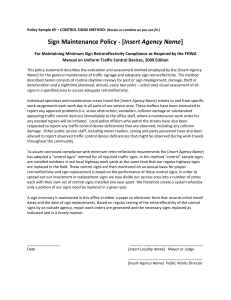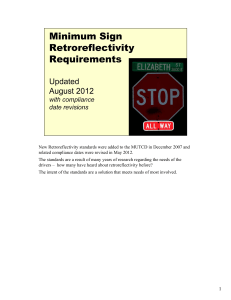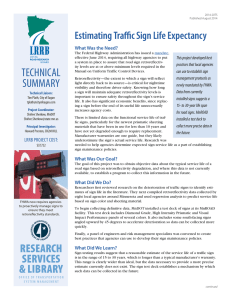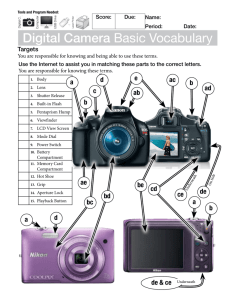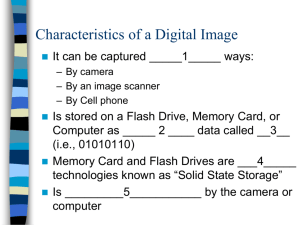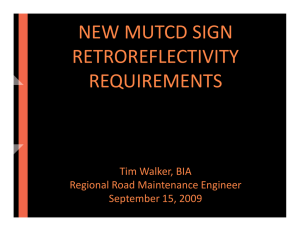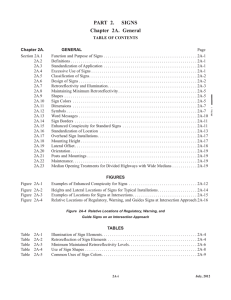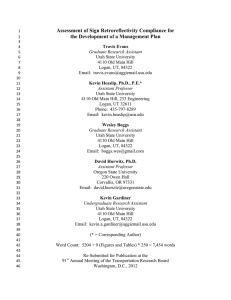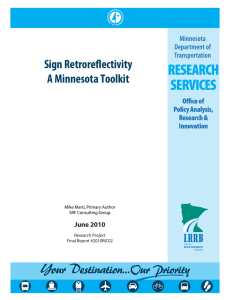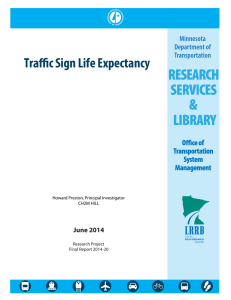Sign Retro reflectometers
advertisement
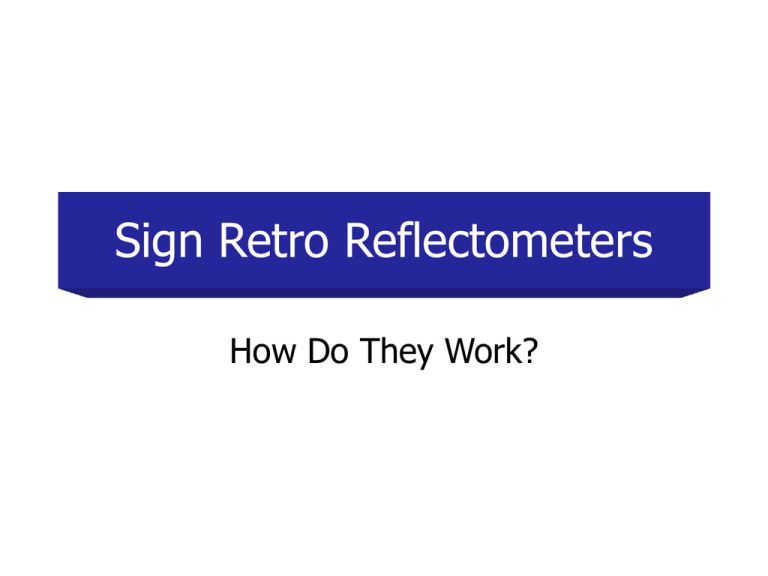
Sign Retro Reflectometers How Do They Work? Traffic signs serve motorists by providing various regulatory, advisory, or directional information. When the signs are new they serve their purpose well. As they get old they degrade — lose some of their color, legibility, visibility, and retroreflectance. While loss of retroreflectance is not always noticeable under daylight conditions, older signs are often difficult to read at night under headlights. Due to the degradation of retroreflective materials over the course of years, it is important to have a basis for knowing when to replace signs. Although the MUTCD states that regulatory and warning signs, and most guide signs, need to be reflectorized (or illuminated), no level of retroreflectivity is specified. In recognition of this situation, Congress directed the Department of Transportation (through the 1993 Appropriations Act) to revise the MUTCD so that it includes a standard for a constant, minimum level of retroreflectivity. The Federal Highway Administration initiated a program aimed at developing instruments and tools to measure the retroreflectance of traffic signs, so that when signs have reached the end of their useful life they can be replaced. Let’s take a look at the instruments for measuring traffic sign retroreflectivity — what they are, how they work, and how they contribute to improved nighttime visibility of traffic signs. The hand-held retroreflectometer is an instrument capable measuring the retroreflection properties of traffic signs accurately and reliably. They can be deployed widely in the field to spot check the condition of traffic signs. They allow highway agencies to maintain minimum performance specifications for traffic signs, and can support a sign management program. The RetroSign Type 4500 Features • A traceable calibration standard to an accredited national standards laboratory • Is calibrated on a single reference standard for all colors and types of sign sheeting materials • Stores software-compatible data internally with user-set identification labels The Model 920L Retroflectometer with Data Logger Features • Calibration corrections for different colors and material types are programmed in the PC software package furnished with retroflectometer. • Software to transfer the data collected to a PC. • Extension pole to facilitate measuring road signs. Mobile Sign Retroreflectometer Van The van uses a calibrated strobe lamp, mounted on top, to bounce light off highway signs. The returned light is processed by computer to account for observation, angle, and distance, and is then measured and compared to guidelines. Mobile Sign Retroreflectometer Van Equipment The mobile sign retroreflectometer van is a prototype system. It can measure the retroreflectance of traffic signs during daylight hours at highway speeds. It effectively and economically measures the retroreflectivity of the signs. The system will track the designated sign and, at 200 feet, will flash the sign and perform retroreflectivity calculation. This information along with the GPS coordinates and other data associated with that particular sign will be stored in the systems database. The data will be used to evaluate the sign, and will be the beginning of a sign inventory. The equipment consists of a laser range finders, a color video aiming camera, two B&W video cameras, a high-intensity xenon flash unit, a pan tilt mount (to rotate the flash unit), a system computer and monitor, image processing and image capture cards, and a van vehicle equipped with GPS. The equipment is readily available off-the-shelf. The following equipment for the mobile sign retroreflectometer van is easy to acquire, readily available, and works off-the-shelf. Laser Range Finder Optec Systems • 1,000 ft range on 20% reflective surface • 5cm accuracy • 8kHz sampling rate • 6 ft beamwith at 200 ft (approximately) • Naked Eye Safe • Class 1 laser product Color Camera Pulnix TMC - 7 • 768 (H) x 494 (V) Resolution • 1/2 inch CCD • Shutter Speed for 1/60 to 1/10,000 sec • 50mm Lens B&W Cameras 1 & 2 Pulnix - 72EX • 768 (H) x 494 (V) Resolution • 2/3 inch CCD • Shutter Speed for 1/60 to 1/10,000 sec • Camera #1 has a 50 mm Lens, while Camera #2 has a 75mm Lens Flash Unit Hughey & Philips SS1125 StrobeGuard (modified) • Xenon Flash Tube • 270,000 Candelas of light intensity • 1 second flash recharge time • Daytime use ONLY Pan Tilt Mount Rotating Precision Mechanisms, Inc. • 25 deg/sec maximum velocity in azimuth and elevation • 40 deg/sec maximum acceleration • Full computer control of azimuth and elevation System Computer • Dual- processor Intel Pentium 200 MHz System • 2 Gigabyte internal HD • 2 Gigabyte removable HD for data • SCSI interface for HD, Zip drive & CDROM • Windows NT 4.0 Operating System Monitor Computer Dynamics, Inc. • 13.8” LCD Flat Panel Display • 1024 x 768 resolution • 5”total depth of monitor and enclosure Image Processing & Capture Processing SHARP GPB-2 • 25 MHz, 40 ns/pixel processing rate Capture VGX 4 Megabyte Frame Grabber • 8-bit resolution Vehicle Ford Motor Corporation • Regular length Club Wagon • Heavy duty suspension and alternator • 2,000-watt inverter installed for AC power • Racks installed to house associated equipment GPS Unit Magellan System Corporation • 10 Channel GPS Sensor • 100 meter resolution • Differential GPS ready (1- meter resolution) Mobile Sign Retroreflectometer Van Operation A driver and a operator are needed to use the system. While the driver maneuvers the vehicle, the operator aims the optical head toward an oncoming traffic sign using a computer mouse and automatic tracking system. This locates and tracks the sign by way of the color video camera. When the system is at the required distance from the sign (200 feet), the range finder fires the xenon flash, and the sign image is captured by the appropriate B&W video camera. A histogram is produced of the sign’s legend and background, which is used to calculate retroreflectivity of each in cd/lux/m2. This information, along with the GPS coordinates, sign images--color image of sign, B&W, and histogram--is recorded in the sign management system’s data base. The data exists in a raw format that can be inputted into a database management system. Sign Management At FHWA, we believe that highway agencies should provide signs that are detectable and legible at the required distance for the vast majority of drivers, both day and night. For signs that rely on their retroreflectivity properties, it is paramount that they do not degrade to a level that cannot achieve this objective. Consequently, FHWA is encouraging implementation of a sign management program. FHWA is currently preparing an Advance Notice of Proposed Rulemaking regarding the minimum retroreflectivity guidelines. The rulemaking process provides an opportunity for all interested parties to comment on the proposal. For More Information For more information about Retroreflectivity, contact: Peter J. Hatzi HTA-30 (202) 366-8036 Federal Highway Administration
